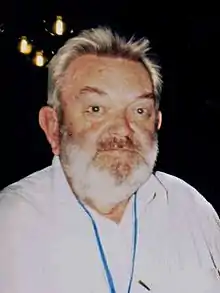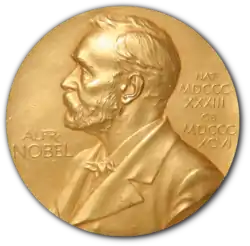Martinus J. G. Veltman
Martinus Justinus Godefriedus "Tini" Veltman (Dutch pronunciation: [mɑrˈtinʏʃʏsˈtinʏs xoːdəˈfridʏs ˈtini ˈvɛltmɑn];[1] 27 June 1931 – 4 January 2021)[2][3][4] was a Dutch theoretical physicist. He shared the 1999 Nobel Prize in physics with his former PhD student Gerardus 't Hooft for their work on particle theory.[5]
Martinus J. G. Veltman | |
|---|---|
 Veltman in 2005 | |
| Born | Martinus Justinus Godefriedus Veltman 27 June 1931 Waalwijk, Netherlands |
| Died | 4 January 2021 (aged 89) Bilthoven, Netherlands |
| Nationality | Dutch |
| Alma mater | Utrecht University |
| Awards | Nobel Prize in Physics (1999) |
| Scientific career | |
| Fields | Physics |
| Institutions |
|
| Thesis | Intermediate particles in S-matrix theory and calculation of higher order effects in the production of intermediate vector bosons (1963) |
| Doctoral advisor | Léon C. P. van Hove |
| Doctoral students | |
Biography
Martinus Justinus Godefriedus Veltman was born in Waalwijk, Netherlands, on 27 June 1931. His father was the head of the local primary school. Three of his father's siblings were primary school teachers. His mother's father was a contractor and also ran a café. He was the fourth child in a family with six children. He started studying mathematics and physics at Utrecht University in 1948.[6]
As a youth he had a great interest in radio electronics, which was a difficult hobby to work on because the occupying German army had confiscated most of the available radio equipment.[6]
In 1955, he became an assistant to Prof. Michels of the Van Der Waals laboratory in Amsterdam. Michels was an experimental physicist, working in high pressure physics. His primary task was the upkeep of a large library collection and occasional lecture preparations for Michels.
His research career advanced when he moved to Utrecht to work under Leon Van Hove in 1955. He received his MSc degree in 1956, after which he was drafted into military service for two years, returning in February 1959. Van Hove then hired him as a doctoral researcher, even though he was now 27 years old. He obtained his PhD degree in theoretical physics in 1963 and became professor at Utrecht University in 1966.[6]
In 1960, Van Hove became director of the theory division at CERN in Geneva, Switzerland, the European High Energy laboratory. Veltman followed him there in 1961. Meanwhile, in 1960, he married his wife Anneke, who gave birth to their daughter Hélène in the Netherlands, before moving to Geneva to live with Martinus. Hélène followed in her father's footsteps and in due time completed her particle physics thesis with Mary Gaillard at Berkeley, though she now works in the financial industry in London.[6]
In 1963/64, during an extended stay at SLAC he designed the computer program Schoonschip for symbolic manipulation of mathematical equations, which is now considered the very first computer algebra system. Veltman continued to be interested in using computers to solve physics problems, meeting with Stephen Wolfram in 1979 to provide inspiration for Symbolic Manipulation Program, a precursor to Mathematica.[7]
Veltman was closely involved in the 1963 CERN neutrino experiment, analyzing images as they were generated by the detectors. When no spectacular events came out, enthusiasm waned, and after a while Veltman and Bernardini were the only ones analyzing the images. As a result, Veltman became the spokesman for the group at the Brookhaven Conference in 1963.[6]
In 1971, Gerardus 't Hooft, who was completing his PhD under the supervision of Veltman, renormalized Yang–Mills theory. They showed that if the symmetries of Yang–Mills theory were to be realized in the spontaneously broken mode, referred to as the Higgs mechanism, then Yang–Mills theory can be renormalized.[8][9] Renormalization of Yang–Mills theory is a major achievement of twentieth century physics.
In 1980, Veltman became member of the Royal Netherlands Academy of Arts and Sciences.[10] In 1981, Veltman left Utrecht University for the University of Michigan-Ann Arbor,[11] from where he retired in 1996. [12] He subsequently moved back to the Netherlands.
Eventually, he shared the Nobel Prize for Physics in 1999 with 't Hooft, "for elucidating the quantum structure of electroweak interactions in physics".[6] Veltman and 't Hooft joined in the celebrations at Utrecht University when the prize was awarded.
In 2003, Veltman published a book about particle physics for a broad audience, entitled Facts and Mysteries in Elementary Particle Physics.
On 4 January 2021, Veltman died in his home in Bilthoven, the Netherlands.[13]
Asteroid 9492 Veltman is named in his honor.
Bibliography
- Veltman, M. "Perturbation Theory of Massive Yang-Mills Fields", Utrecht Rijksuniversiteit (Netherlands). Instituut voor Theoretische Fysica. Paris Univ., Orsay (France). Laboratoire de Physique Théorique et Hautes Energies, (Aug. 1968).
- Veltman, M. & J. Yellin. "Some Comments on the Decays of eta (550)", Brookhaven National Laboratory, United States Department of Energy (through predecessor agency the Atomic Energy Commission), July 1966.
- Veltman, M. Facts and Mysteries in Elementary Particle Physics, World Scientific Publishing, 2003. ISBN 981-238-149-X.
References
- In isolation, Martinus, Justinus and Godefriedus are pronounced [mɑrˈtinʏs], [jʏsˈtinʏs] and [ɣoːdəˈfridʏs].
- "Nobelprijswinnaar Martin Veltman (1931) overleden". NRC (in Dutch).
- "Nobelprijswinnaar Martinus Veltman (89) overleden". Telegraaf. 6 January 2021.
- "Martinus Veltman (1931 – 2021)". CERN. Retrieved 12 January 2021.
- Iliopoulos, John; Maiani, Luciano (20 January 2021). "Martinus Justinus Godefriedus Veltman (1931 – 2021)". CERN. Retrieved 27 January 2021.
- Martinus J. G. Veltman on Nobelprize.org

- Wolfram, Stephen (21 January 2021). "Tini Veltman (1931–2021): From Assembly Language to a Nobel Prize". Wolfram Writings.
- G. 't Hooft and M. Veltman (1972). "Regularization and Renormalization of Gauge Fields". Nuclear Physics B. 44 (1): 189–219. Bibcode:1972NuPhB..44..189T. doi:10.1016/0550-3213(72)90279-9. hdl:1874/4845.
- "Regularization and Renormalization of Gauge Fields by 't Hooft and Veltman (PDF)" (PDF).
- "Martinus Veltman". Royal Netherlands Academy of Arts and Sciences. Archived from the original on 25 November 2020.
- "Nobel Prize winners - Organisation - Universiteit Utrecht". www.uu.nl.
- "Martinus Justinus Godefriedus Veltman". www.newnetherlandinstitute.org.
- "Nobel prize winner Martinus Veltman passed away - News - Universiteit Utrecht". www.uu.nl. 6 January 2021. Archived from the original on 6 January 2021.
External links
| Wikimedia Commons has media related to Martinus Veltman. |
| Wikiquote has quotations related to: Martinus J. G. Veltman |
- Martinus J. G. Veltman on Nobelprize.org
 including the Nobel Lecture 8 December 1999 From Weak Interactions to Gravitation
including the Nobel Lecture 8 December 1999 From Weak Interactions to Gravitation - University of Michigan Page
- Freeview video 'An Interview with Martinus Veltman' by the Vega Science Trust
- Freeview video 'Why do we need a linear collider'
- Martinus J. G. Veltman on INSPIRE-HEP

- Tini Veltman (1931–2021): From Assembly Language to a Nobel Prize
